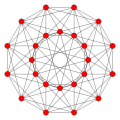16-cell honeycomb
From Wikipedia, the free encyclopedia
In four-dimensional Euclidean geometry, the 16-cell honeycomb is one of the three regular space-filling tessellations (or honeycombs), represented by Schläfli symbol {3,3,4,3}, and constructed by a 4-dimensional packing of 16-cell facets, three around every face.
| 16-cell honeycomb | |
|---|---|
 Perspective projection: the first layer of adjacent 16-cell facets. | |
| Type | Regular 4-honeycomb Uniform 4-honeycomb |
| Family | Alternated hypercube honeycomb |
| Schläfli symbol | {3,3,4,3} |
| Coxeter diagrams | |
| 4-face type | {3,3,4} |
| Cell type | {3,3} |
| Face type | {3} |
| Edge figure | cube |
| Vertex figure |  24-cell |
| Coxeter group | = [3,3,4,3] |
| Dual | {3,4,3,3} |
| Properties | vertex-transitive, edge-transitive, face-transitive, cell-transitive, 4-face-transitive |
Its dual is the 24-cell honeycomb. Its vertex figure is a 24-cell. The vertex arrangement is called the B4, D4, or F4 lattice.[1][2]
Alternate names
- Hexadecachoric tetracomb/honeycomb
- Demitesseractic tetracomb/honeycomb
Coordinates
Vertices can be placed at all integer coordinates (i,j,k,l), such that the sum of the coordinates is even.
D4 lattice
The vertex arrangement of the 16-cell honeycomb is called the D4 lattice or F4 lattice.[2] The vertices of this lattice are the centers of the 3-spheres in the densest known packing of equal spheres in 4-space;[3] its kissing number is 24, which is also the same as the kissing number in R4, as proved by Oleg Musin in 2003.[4][5]
The related D+
4 lattice (also called D2
4) can be constructed by the union of two D4 lattices, and is identical to the C4 lattice:[6]




 ∪
∪ 



 =
= 





 =
= 








The kissing number for D+
4 is 23 = 8, (2n − 1 for n < 8, 240 for n = 8, and 2n(n − 1) for n > 8).[7]
The related D*
4 lattice (also called D4
4 and C2
4) can be constructed by the union of all four D4 lattices, but it is identical to the D4 lattice: It is also the 4-dimensional body centered cubic, the union of two 4-cube honeycombs in dual positions.[8]




 ∪
∪ 



 ∪
∪ 



 ∪
∪ 



 =
= 



 =
= 



 ∪
∪ 



 .
.
The kissing number of the D*
4 lattice (and D4 lattice) is 24[9] and its Voronoi tessellation is a 24-cell honeycomb, ![]()
![]()
![]()
![]()
![]() , containing all rectified 16-cells (24-cell) Voronoi cells,
, containing all rectified 16-cells (24-cell) Voronoi cells, ![]()
![]()
![]()
![]()
![]()
![]()
![]() or
or ![]()
![]()
![]()
![]()
![]()
![]()
![]() .[10]
.[10]
Symmetry constructions
Summarize
Perspective
There are three different symmetry constructions of this tessellation. Each symmetry can be represented by different arrangements of colored 16-cell facets.
| Coxeter group | Schläfli symbol | Coxeter diagram | Vertex figure Symmetry |
Facets/verf |
|---|---|---|---|---|
| = [3,3,4,3] | {3,3,4,3} | [3,4,3], order 1152 | 24: 16-cell | |
| = [31,1,3,4] | = h{4,3,3,4} | [3,3,4], order 384 | 16+8: 16-cell | |
| = [31,1,1,1] | {3,31,1,1} = h{4,3,31,1} | [31,1,1], order 192 | 8+8+8: 16-cell | |
| 2×½ = [[(4,3,3,4,2+)]] | ht0,4{4,3,3,4} | 8+4+4: 4-demicube 8: 16-cell |
Related honeycombs
Summarize
Perspective
It is related to the regular hyperbolic 5-space 5-orthoplex honeycomb, {3,3,3,4,3}, with 5-orthoplex facets, the regular 4-polytope 24-cell, {3,4,3} with octahedral (3-orthoplex) cell, and cube {4,3}, with (2-orthoplex) square faces.
It has a 2-dimensional analogue, {3,6}, and as an alternated form (the demitesseractic honeycomb, h{4,3,3,4}) it is related to the alternated cubic honeycomb.
This honeycomb is one of 20 uniform honeycombs constructed by the Coxeter group, all but 3 repeated in other families by extended symmetry, seen in the graph symmetry of rings in the Coxeter–Dynkin diagrams. The 20 permutations are listed with its highest extended symmetry relation:
| D5 honeycombs | |||
|---|---|---|---|
| Extended symmetry |
Extended diagram |
Extended group |
Honeycombs |
| [31,1,3,31,1] | |||
| <[31,1,3,31,1]> ↔ [31,1,3,3,4] |
↔ |
×21 = |
|
| [[31,1,3,31,1]] | ×22 | ||
| <2[31,1,3,31,1]> ↔ [4,3,3,3,4] |
↔ |
×41 = | |
| [<2[31,1,3,31,1]>] ↔ [[4,3,3,3,4]] |
↔ |
×8 = ×2 | |
See also
Regular and uniform honeycombs in 4-space:
Notes
References
Wikiwand - on
Seamless Wikipedia browsing. On steroids.


 ...
...



